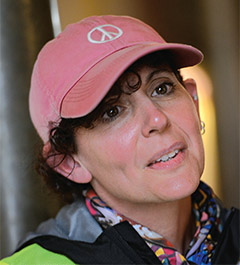 Maria DeAngelo is a middle school math and science teacher and member of the Saranac Lake Teachers Association. A marathon walker, she put on her sneakers in mid-April and blazed more than 150 miles from Saranac Lake to Albany on a four-day "Walk in Our Shoes" proclamation on behalf of all public education students. Union colleagues and other supporters joined her at points along the way.
Maria DeAngelo is a middle school math and science teacher and member of the Saranac Lake Teachers Association. A marathon walker, she put on her sneakers in mid-April and blazed more than 150 miles from Saranac Lake to Albany on a four-day "Walk in Our Shoes" proclamation on behalf of all public education students. Union colleagues and other supporters joined her at points along the way.
DeAngelo designed her own T-shirt for the walk — a picture of a sneaker with wings — and brought along drawings of sneakers made by students to deliver to state lawmakers at the Capitol. Each drawing was colored and included words the students said they value most about school, such as "physical education," "seeing friends," "art class," and "kind teachers."
1. What motivated you to trek 152 miles on roadways through the Adirondacks and then through suburbs and cities?
When I walk, I walk to think and solve problems. I'd just like to get the word out there: We've lost sight of our true goals and constitutional rights. Public schools have lost $5.9 billion in Gap Elimination Adjustment (GEA). (Since the 2009-10 school year, the state has deducted money from each district's state aid allocation to help the state fill its revenue shortfall). That's $2,800 a kid ... We need to get people to understand how this affects students. There's a constitutional right to provide a sound education. The governor needs to respect teachers and learning.
2. Why walk now?
Every time we turn around we're being told, "You're not good enough." Teachers make things happen. They make sure students have what they need. There are students who may need a breakfast, warm clothes, a safe place to be. The governor is being rather disrespectful, without standing in the shoes of our students and seeing what it's like for them. I think people don't realize our funding is lower than it used to be. We've lost staff, programs, resources. With GEA, high-stakes testing, and developmentally inappropriate learning, we're at a tipping point.
3. How did you plan your walk?
I left school on a Friday morning, after math class. It was an important class because students were preparing for a big test. I started walking right from school. I wanted to be back by the following Tuesday because I had to administer the (state) math test. I used personal time. My husband followed me in his Jeep with food and emergency supplies, extra pairs of sneakers, and my laptop, because I had to do grades at night.
4. You've been teaching since 1990. How have you seen budget cuts affect school?
I used to be an art teacher, but that position was eliminated three years ago [due to budget cuts]. I am dually certified in math and art, so now I teach math and science, as well as skills for adolescence. I am still working with kids — sixth-graders are amazing — and I still teach art club. I realize every district has had to make decisions: to have pre-K or not? How to handle unfunded mandates? Underfunding our schools has cost our kids their teachers, counselors, arts programs and sports programs.
5. How do you see testing and Common Core affecting students?
Students in grades 3-8 spend 105 hours just sitting for the test. That's not including preparation time, and what developmental lessons had to be set aside to prepare for the tests. Some elements of Common Core I can appreciate, but the way everything was rolled out —kids are tested on lessons there are not even modules for yet. We talk to kids about doing their best but it's set up so they won't. They're high-stress tests and not developmentally appropriate. Education means lighting a fire under a kid and helping him find his passion. We need to find our way again.